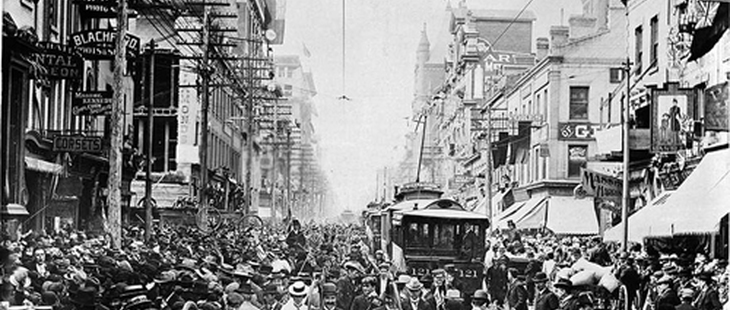
Back when everyone shared the road. (City of Toronto Archives) Toronto is bike crazy. We freak the hell out when we lose a bike lane on a road, there’s now a bike shop about every 500 metres, there’s a cool magazine devoted to biking just in Toronto, and we have a relatively powerful biking union. But believe me when I say, compared to what it was once like, this city doesn’t give a damn about the bicycle. It was the 1890s when the bicycle became the preferred mode of getting around, both for recreation and commuting, thanks to a combination of technological innovation, protectionist economic policies, and changing social mores. There were bikes before the 1890s, but, to be delicate about it, they sucked. It wasn’t until we neared the century’s end that someone realized the ride would be way more comfortable if pneumatic tires were used instead of, oh, wood or metal ones. New smooth-riding bikes replaced what were affectionately known as bone shakers. And given border tariffs importing bikes was prohibitively expensive, but they were cheap to make here. Factory after factory after factory opened in Southern Ontario, and with the bike market flooded, prices dropped to the point where virtually anyone could afford one. (City of Toronto Archives) And everyone rode. An 1895 city commissioned count found that between 6:00 and 6:30 am 395 cyclists travelled westbound via King St. into the downtown. By comparison, only 29 riders take that same route, at the same time, today. Employers across the city invested in bike infrastructure for their workers (most factories had bike locker rooms) and the owners of the for-profit transit system complained that bikes were stealing much of their business. If many rode to work, many more jumped on their bike in the evenings and on the weekends. Cycling groups and unions proliferated: the largest, the Canadian Wheelman’s Association, organized weekly races and bike shows, put out a bi-weekly magazine (Cycling) and held massive public meetings. Ads for the latest, greatest and most comfortable bicycles filled the newspapers as did debates between bicycle and tricycle advocates (which was safer? Which would prove more popular in the twentieth century?). Heralding the 21st century advent of the BikeTrain, hundreds boarded trains with their bikes on the weekends to explore different parts of the province. (City of Toronto Archives) Remarkably, the political questions associated with cycling are relatively unchanged. In the 1890s Toronotonians were preoccupied with the question of ‘scorchers’: those riders who travelled too quickly, ignored rules of the road, and endangered pedestrians. Similarly, there was a concerted effort to improve the quality of the city’s streets for cyclists. The ‘Good Roads Campaign’ argued that city council needed to set aside more money to pave roads for the benefit of the bike rider. Though, unlike today, their priority was to make suburban roads more bike-friendly to allow for people to leave the city easily on weekends. Finally, cyclists successfully courted political power. Candidates for both the mayoralty and council made a point of wooing the biking lobby, often showing up at meetings of cyclists to expound upon their respective platforms. If there was an important question in Toronto, the bike unions were sure to be involved somehow. By the end of World War II, however, the cycling heyday was over. Cycling as something like a movement, or aspect of civic consciousness, or popular sport, didn’t really return until the ’80s, and gain serious momentum in the 2000s. But don’t be mistaken, for all the squabbling over cyclists’ rights and safety, the Bixi-love, the fixed-gear bike as style accoutrement, and no matter how many riders show up for a critical mass, we still have a long way to go before we match the intensity and omnipresence of the cycling culture from more than a century ago. __ Simon Wallace writes the Standard Historical Society column for Toronto Standard.














